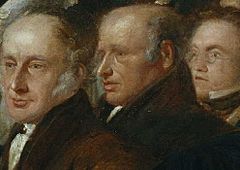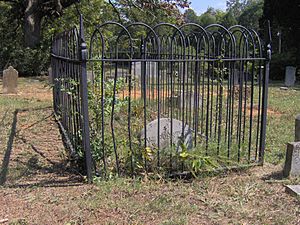William Forster (philanthropist) facts for kids
Quick facts for kids
William Forster
|
|
|---|---|

William between two fellow abolitionists (George Stacey and William Morgan) in a detail from a painting.
|
|
| Born | March 23, 1784 |
| Died | January 27, 1854 (aged 69) |
| Resting place | Friendsville, Tennessee |
| Nationality | English |
| Occupation | Preacher and abolitionist |
| Known for | Slavery abolitionist |
| Spouse(s) | 1.Rachel Wilson 2.Sarah Dillworth |
| Children | William Edward |
| Parent(s) | William Forster (1747–1824)and Elizabeth Hayward (1759–1837) |
| Relatives | Josiah Forster (brother), Elizabeth Fry Sister-in-law |
William Forster (March 23, 1784 – January 27, 1854) was a dedicated preacher and a leader in the Quaker religious group. He was also a very strong supporter of ending slavery. In 1839, he became an early member of the British and Foreign Anti-Slavery Society. William Forster and Stephen Grellet helped Elizabeth Fry discover her important work improving prisons. William's brother, Josiah Forster, even joined Elizabeth Fry on her trips to check prisons in France.
Contents
William Forster's Early Life and Work
William Forster was born in 1784. He first trained to be a land agent, which meant he managed land for others. After this, he became a minister and traveled around England and Scotland. He visited the Hebrides in 1812 and Ireland in 1813–1814.
Helping Prisoners with Elizabeth Fry
When William Forster visited Newgate prison with Stephen Grellet, he was shocked by its poor conditions. He told Elizabeth Fry about what he saw. Elizabeth Fry then brought together a group of women to help make prisons better. This is how William Forster helped Elizabeth Fry start her life's important work.
Fighting for Freedom from Slavery
In 1816, Forster married Anna Buxton. They moved to Dorset. When Anna's brother, Sir Thomas Fowell Buxton, became a member of parliament in 1818, William wrote to him. He encouraged his brother-in-law to support the fight against slavery. William pointed out that while the slave trade had been stopped in 1807, many people were still enslaved.
Quaker Beliefs and Travels to America
There were some disagreements among Quakers because of the ideas of Elias Hicks from New York. William Forster brought attention to this issue in 1820. Important English Quakers, including Elizabeth Robson, Forster, and Anna Braithwaite, traveled to the United States. Between 1821 and 1827, they spoke out against Hicks' views.
Meanwhile, in Britain, new laws were passed that helped end slavery. In 1838, a law changed slavery into an "apprenticeship" system. This meant that in August 1838, about 800,000 people in the British Empire became free, at least in name.
Joining the Anti-Slavery Society
A painting was made showing William Forster as a member of the new British and Foreign Anti-Slavery Society. This group was formed in 1839 at a big international meeting in June 1840. The part of the painting shown here includes Samuel Gurney, who was a banker and a Quaker like Forster, along with Forster himself, and William Allen. William's brothers, Robert Forster and Josiah Forster, were also in the painting.
The goal of this new society was to completely end slavery and the slave trade everywhere. They also wanted to protect the rights of people who had been freed in British areas and all people who were captured as slaves.
Solving Quaker Differences in America
In 1842-1843, a disagreement happened among the Society of Friends (Quakers) in Salem, Iowa. The problem was about how the group should support ending slavery, which was still a big part of the American economy. A new meeting house was built, and a new burial ground was bought. It was separated from the old Quaker burial ground by only two feet of land.
Four Quaker leaders were sent from Britain to help: Forster, his brother Josiah, George Stacey (who is in the painting above), and John Allen. The main difference between the two groups was how much they should publicly oppose slavery. The group that most strongly supported ending slavery had formed a smaller group called the Abolition Friends. The British delegates could not fix the problem right away, but it was finally settled by 1848.
In July 1845, Forster and his wife visited France. They were invited by French people who wanted to end slavery. They found some activity in Paris, but they were disappointed that there wasn't much happening in the rest of the country.
William Forster's Final Journey

In 1849, the yearly meeting of the Quakers asked William Forster to visit the leaders of Christian nations. Forster visited many rulers in Europe to promote the cause of ending slavery.
Then, in 1853, he and three other people visited the American president, Franklin Pierce. They also traveled to spread their message to the governors of the southern American states, meeting thirteen of them. It was during this important journey that William Forster died. He was buried in the Quaker town of Friendsville, Tennessee in Tennessee. This town was also a stop on the Underground Railroad, a secret network that helped enslaved people escape to freedom.
The famous poet, John Greenleaf Whittier, wrote a poem to remember William Forster. Forster had visited Whittier's parents' home during his first trip to America. William Forster's son, William Edward Forster, later became a member of parliament. He worked hard to make sure everyone could get an education.

